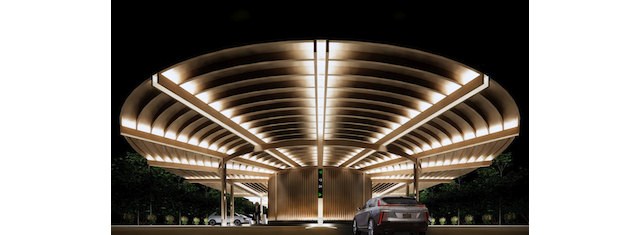Technology
THE ELECTRIC FUELLING STATION OF THE FUTURE
NOTHING LIKE THE GAS STATION OF THE PAST

The Electric Fuelling Station* (Source: Electric Autonomy Canada)
USPA NEWS -
Electric Autonomy Canada, in partnership with Parkland Corporation, launched an ideas competition which called for inspiring concepts that could serve as a blueprint for what future fuelling stations dedicated to electric vehicle (EV) charging could look like. The goal of the competition was to advance EV adoption and alleviate "range anxiety" by highlighting the benefits of recharging on a long road trip, especially at a hub designed for that purpose.
Electric Autonomy Canada, in partnership with Parkland Corporation, launched an ideas competition which called for inspiring concepts that could serve as a blueprint for what future fuelling stations dedicated to electric vehicle (EV) charging could look like. The goal of the competition was to advance EV adoption and alleviate "range anxiety" by highlighting the benefits of recharging on a long road trip, especially at a hub designed for that purpose.
Drawing over 100 high-quality entries from across the world, what emerged from the competition were many innovative concepts that redefine modern mobility – all fuelled by the minds of passionate architects and designers.
Chosen by an acclaimed judging panel that included leading architects, retail experts, EV drivers and even the designer behind the LYRIQ, Cadillac's first EV, the winning entrants from the competition include: in first place 'More with Less', designed by James Silvester from Edinburgh, Scotland. In second place is 'The Circle' by Fabric.a Architects from Istanbul, Turkey, and in third place is 'Plug and Play' by Pavel Babiienko from Berlin, Germany. These winners will be awarded $40,000 CAD in total prize money between them. The winning design concept, 'More with Less,' is a timber-framed pavilion that provides charging bays under the shelter of a curvilinear canopy.
Chosen by an acclaimed judging panel that included leading architects, retail experts, EV drivers and even the designer behind the LYRIQ, Cadillac's first EV, the winning entrants from the competition include: in first place 'More with Less', designed by James Silvester from Edinburgh, Scotland. In second place is 'The Circle' by Fabric.a Architects from Istanbul, Turkey, and in third place is 'Plug and Play' by Pavel Babiienko from Berlin, Germany. These winners will be awarded $40,000 CAD in total prize money between them. The winning design concept, 'More with Less,' is a timber-framed pavilion that provides charging bays under the shelter of a curvilinear canopy.
With a clear societal push towards a cleaner, greener future, Parkland has plans to build the winning design of the 'Electric Fuelling Station of the Future,' moving the concept from the page to the real world. With the goal of setting the global standard for electric vehicle charging and customer experience, Parkland plans to bring the winning concept to life as part of their ambitious electric vehicle charging strategy in British Columbia, Canada.
"From Turkey to Kazakhstan, Poland to Portugal and China to Canada, our team and jury was overwhelmed with the quality of submissions from around the globe. We're confident that the concepts will spark a holistic rethinking - from the ground up - of the unique refuelling requirements and opportunities of EVs versus gas vehicles. It demonstrates great leadership that Parkland has committed to build the winning design," said Nino Di Cara, Founder and President, Electric Autonomy Canada.
"Consistent with our energy transition and convenience destination strategy, our goal in sponsoring this competition was to engage talented architects and designers from around the world, invite them to put the needs of electric vehicle customers first, and entirely reimagine their experience," said Darren Smart, SVP Energy Transition and Corporate Development. "We are committed to bringing the winning concept to life as part of our ambitious electric vehicle charging strategy in British Columbia and believe the concept could be extended to our other geographies when we see an opportunity to meet emerging customer demand."
More details on the competition and winning designs are available at evcharging.electricautonomy.ca/awards2022.
* Photo cover: The Electric Fuelling Station of the Future design competition winning concept ‘More with Less’ by James Silvester from Edinburgh, Scotland
Source: Electric Autonomy Canada
Ruby BIRD
http://www.portfolio.uspa24.com/
Yasmina BEDDOU
http://www.yasmina-beddou.uspa24.com/
* Photo cover: The Electric Fuelling Station of the Future design competition winning concept ‘More with Less’ by James Silvester from Edinburgh, Scotland
Source: Electric Autonomy Canada
Ruby BIRD
http://www.portfolio.uspa24.com/
Yasmina BEDDOU
http://www.yasmina-beddou.uspa24.com/
Ruby Bird Yasmina Beddou Gas Station Past Future Electric Fuelling Station Electric Autonomy Canada Parkland Corporation Ideas Competition Electric Vehicle Charging
Liability for this article lies with the author, who also holds the copyright. Editorial content from USPA may be quoted on other websites as long as the quote comprises no more than 5% of the entire text, is marked as such and the source is named (via hyperlink).





